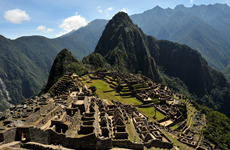
|
|
| Costa and Sierra |
|
 |
| Classic Peru |
|
| Day 1: Arrival in Lima (mostly in the evening). Accommodation in Lima - Route: ca 25 km |
daily program |
| Arrival at the International Airport Jorge Chavez in Lima. You will be welcomed by your tour conductor, who will accompany you to the modern area of Miraflores, and will help you check into your hotel. Depending on your arrival time, you will have time to enjoy dinner at Kennedy Park or walk to the modern shopping center Larco Mar, and take a first stroll by the Pacific Ocean. Your local tour conductor is there to help you with any questions you might have. |
|
| Day 2: City Tour and Larco Herrera Museum. Accommodation in Lima - Route: ca 15 km |
daily program |
| In the morning, we invite you to join us on a city tour in a comfortable coach. Our visit of Lima, city of contrasts, starts with the colonial heart of the city, with its beautiful mansions with wooden balconies. First you’ll see the Plaza Mayor, surrounded by the cathedral, the Archbishops’ Palace and the Palace of government. The Cathedral houses the tomb of Francisco Pizarro. Highlights of the San Francisco Convent are its library, choir stall and the catacombs, first discovered in 1951. After your guided tour, it will be easy to understand why UNESCO declared the old town as World Heritage. Lima’s modern districts Miraflores and San Isidro with their attractive buildings, banks and embassies offer many photo opportunities.In the afternoon, a visit to the Larco Herrera Museum is planned. The museum, founded by Peruvian architect Rafael Larco Hoyle in 1926, provides an excellent overview of 3000 years of pre-Columbian history. The museum is located in an 18th century mansion surrounded by beautiful gardens. It features the finest gold and silver collection from ancient Peru and a famous erotic archaeological collection, one of the most visited tourist attractions in Peru. |
|
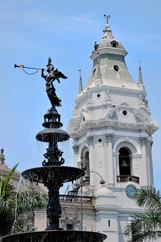 |
|
| Day 3: Pachacamac and Huacachina Lagoon. Accommodation in Ica - Route: ca 300 km |
daily program |
| Today our journey takes us South on the Panamerican Highway. About an hour into our trip, we stop to visit the ancient temple city of Pachacamac. It was the main sanctuary on the coast of Peru, until the Spanish conquistadors arrived. Presumably, Pachacamac was already a sanctuary before the Inca Empire. Pilgrims would come from all over to consult the oracle. Later, we will drive by fishing villages until we reach Ica. Ica is Peru’s most celebrated wine growing region, and is especially famous for its national drink: Pisco. We visit the Regional Museum, which features ceramics, textiles and treasures found in graves of the pre-Incan Nasca and Paracas cultures. |
|
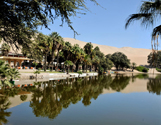 |
|
| Day 4: Ballestas Islands and Nasca-lines. Accommodation in Nasca - Route:ca 280 km |
daily program |
In the morning, we will guide you to Paracas, where you will depart on a motorboat excursion to the Ballestas-islands. They are also known as “Little Galapagos”, because they provide shelter for thousands of sea lions, penguins, pelicans, cormorants and many other sea birds. This little archipelago had a large impact on the Peruvian economy from the 1850’s until the 1890’s. Guano, or bird droppings, were collected on the islands and exported to Europe, where they were used as fertilizer or raw material for explosives.
Unfortunately, the invention of synthetic ammoniac, led to a large decrease in the demand of guano. Many had to kiss their dream of making easy money goodbye. After the boat trip, the journey goes on to Nasca, where you’ll have a chance to fly over the mysterious Nasca-lines. These enormous, geometrical figures can best be observed from high above. There is an observation tower, but to experience this wonder in all its glory, you have to go up into the air. |
|
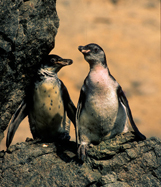 |
|
| Day 5: Nasca-Arequipa with a stop at the Pacific Ocean. Accommodation in Arequipa - Route: ca 280 km |
daily program |
| After leaving Nasca, we drive alongshore. At midday, we stop at the Pacific Ocean, where the bravest among us can venture into the ice cold water. The cold waters of the Humboldt Current may be a downer for swimmers, but are a blessing for fishermen. The richness in fish is unrivaled in this part of the world. In the afternoon, it’s time to leave the coast (=Costa) for the Sierra: we will go up to higher regions for the first time, until reaching Arequipa (2350 m above sea level). Arequipa is Peru’s second largest city (745 000 inhabitants). Contrary to legend, the city’s nickname doesn’t derive from its many buildings in white volcanic stone. Arequipa takes its name from the light-skinned colonials, for whom the city centre used to be reserved. |
|
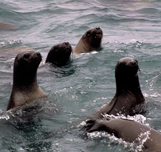 |
|
| Day 6: City tour Arequipa and the Convent of Sta. Catalina. Accommodation in Arequipa - Route: ca 5 km |
daily program |
| In the morning, we invite you to go on a city tour. The city is full of colonial buildings, like the Cathedral and the Jesuit Church La Compañia. In 2000, UNESCO declared the city a World Heritage site on account of the Spanish influence in architecture. The most famous example of 16th Century architecture is the Santa Catalina monastery. Its narrow streets and courtyards make it feel like a ‘city within a city’. Your tour guide will let you in on the secrets of ancient times the monastery holds. In the afternoon, you’ll have a chance to explore this splendid city at your own pace. You can stroll through the charming alleys, or visit mummy Juanita in the Santuarios Andinos museum. |
|
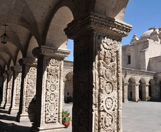 |
|
| Day 7: Colca Canyon and hot springs. Accommodation in Chivay - Route: ca 170 km |
daily program |
| Our five-hour journey is not only a way to get from A to B, but also an adventure. The road will take us through a barren volcanic landscape, in which you’ll hopefully spot some vicuñas, the cousins of the llama. Don’t forget to pack your binoculars! We’ll reach Arequipa in the late afternoon. Allow yourself some time to adjust to the altitude and enjoy a relaxing moment in the natural hot springs. |
|
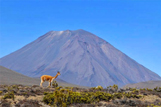 |
|
| Day 8: Cruz del Condor and journey to Puno. Accommodation in Puno - Route: ca 350 km |
daily program |
| We rise early, so we don’t miss the majestic flight of the condors soaring on the early morning winds. At the Condor Cross, you’ll have the opportunity to get a very close look at the kings of the Andes. Take some time to look out over the Canyon, one of the deepest in the world, as well. After this beautiful start of the day, we travel to the highlands, on the way to Puno (3838 m asl). Puno is also known as the “folklore capital of Peru”. In February, during the Candelaria Festival, hundreds of families, mostly from Peru and Bolivia, travel to Puno to enjoy the display of traditional dances and costumes. |
|
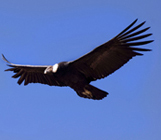 |
|
| Day 9: Uros and Taquile and Shamanic ceremony. Accommodation in Puno - Route: ca 100 km |
daily program |
This morning, we will travel by boat to the floating reed islands of Uros. These islands are anchored to the bottom of the lake, near the shore, where the water is still shallow and the reeds can grow. Uro, the name of the tribe, as well as some of its traditions, have been preserved, although the tribe has intermarried with Aymara and there are no more ‘pure’ Uros. The islands and boats are made of torora, a type of bulrush reed. We invite you to go on a guided tour to learn more about their way of life, even though the islands are now mostly a tourist attraction. In 1996, the government installed solar panels on some of the islands, so they now have electricity.
Afterwards, we’ll make way to Taquile. Upon arrival we’ll take a stroll to the main square, where we’ll have lunch. Unlike in other parts of Titicaca, the tribe who lives on this island isn’t Aymara, but Quechua. They live in a community collective system without private property. The men are skilled knitters and the women weave the highest-quality handicrafts in Peru. Before leaving the island, you’ll have a chance to participate in a shamanic ritual. Experience how the shaman sings in Quechua. “Food”, mostly coca-and rose leaves, are offered to Pachamama, mother Earth, to ensure a good harvest the following year. |
|
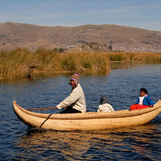 |
|
| Day 10: Journey from Puno to Cusco. Accommodation in Cusco - Route: ca 390 km |
daily program |
| Today, our journey will take us from Puno to Cusco (3420 m asl). During this ca. nine hour drive through the altiplano, you’ll observe sleepy mountain villages. Around noon, we will arrive in the valley of the Vilcanota River. But before that, you will experience the highest point of your trip: the La Raya Pass at 4312 m asl. Afterwards, we’ll descend to a ‘mere’ 3500 m and stop for a visit to the Raqchi ruins. Legend has it the Wiracocha Temple was constructed to honor Wiracocha, the eighth Inca. Later on, we visit Andahuaylillas, where we’ll visit a beautiful colonial church, nicknamed “the Sistine Chapel” of the Americas because of its elaborate decor. In the early evening, we’ll drive into Cusco, the former capital of the Inca Empire. Cusco is Quechua for ‘center of the world’. The architecture in this city is very distinctive due to the mix between indigenous and colonial houses. |
|
 |
|
| Day 11: City tour Cusco and Pachamanca. Accommodation in Cusco - Route: ca 10 km |
daily program |
| The day starts with a visit to the Inca Ruins near Cusco. The four ruins Sacsayhuamán, Q’enqo, Puca Pucará and Tambo Machay are dedicated to the four elements. One wonders how the Inca managed without knowing the wheel. Your tour guide will let you in on different theories. Today, we have a very special lunch on the menu; „Pachamanca“, a tasty dish with three different kinds of meat, potatoes and vegetables. The word is made of two Quechua roots: "pacha" and "manca", meaning "earthen pot". The pot is buried in the earth and covered with hot stones and earth. This ancient cooking tradition is often part of festivities and cooked for a large number of people. We then invite you on a walking city tour. One of the first highlights is the Coricancha-temple, dedicated to the God of the Sun. Huge, tightly-interlocking blocks of stone still stand due to the Inca’s sophisticated stone masonry. Most buildings were destroyed by the Spanish and palaces, convents and churches were built on the remaining foundations. This was the case for Coricancha as well: the Spanish built the Dominic Convent of Santo Domingo on it. The Cusco Cathedral is another must. You will see locals saying prayers to the “Señor de los Temblores”, the patron saint against earthquakes. The cathedral’s paintings are typical examples of the „Cusco School “, an art form that mixes catholic and indigenous themes. |
|
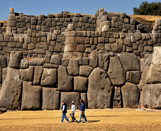 |
|
| Day 12: Sacred Valley with a visit to a farmer’s community. Accommodation in Ollanta - Route: ca 180 km |
daily program |
| The day starts with a visit to the farming community, supported by the Inkaland Tours social project. The road that leads up to the village passes by a breathtaking lagoon, nestled in a beautiful landscape, dotted with mountain peaks. The way of life of people is deeply rooted in rural traditions and has hardly changed for hundreds of years. Their houses are made of adobe and offer barely enough living space. Let the locals show you around and get a glimpse of their everyday life. Marvel at the beauty of the local costumes, or buy souvenirs at the little market. From there, the Maras Salt mines will be our next destination. Maras is a complex of hundreds of small terraced pools, where the highly saline water from a nearby source is collected. The mines have been in use since the Inca-era. The reflection of the sun rays on the water basins bring out different shades in the salt, a true feast for the eyes. Then, we continue to Moray, an equally impressive place of a different kind, where a natural depression was made into different terraces. It most probably was an experimental Inca farm. The round terraces are preserved until today. |
|
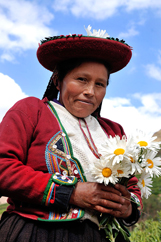 |
|
| Day 13: Machu Picchu. Accommodation in Cusco - Route: ca 200 km |
daily program |
| For many, this is the highlight of the trip. We will travel by train from Ollantaytambo (2800 m asl) to Aguas Calientes, to visit the Lost City of the Inca, tucked away on a hilltop above the Huatanay River. The ruins have a unique magical quality, combined with the peace of the surrounding mountains, that make it a mystical place for many visitors. After our 3 hour guided tour, you’ll have time to take plenty of photos and take in the special energy of the place. Late in the afternoon we head back to the Ollantaytambo train station, from where the coach will take us to Cusco. There will be one more magical stop at an isolated, dark lookout point from where we’ll watch the breath-taking night sky with a thousand stars. |
|
 |
|
| Day 14: Flight to Lima and visit to the Gold Museum. Accommodation in Lima - Route: ca 40 km |
daily program |
| In the morning, enjoy some leisure time in Cusco and get ready for your flight. Upon arrival in Lima, you will once more have the chance to admire the richness of all the cultures you have encountered on this trip. A visit to Lima’s Gold museum will give you an excellent overview. This private collection houses many fascinating gold, silver and copper exhibits, as well as textiles, mummies and ceramics. Most exhibits stem from archeological expeditions for burial treasures from the pre-Inca era. The museum also has a collection named “Weapons of the world”, with swords and armors. |
|
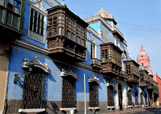 |
|
| Day 15: Flight home. Route: ca 40 km |
daily program |
| You’ll have the morning at your free disposal for last minute shopping and chores. After a farewell lunch with the group in Peru’s most famous restaurant (located on a pier above the Pacific Ocean), we will accompany you to the airport for your connecting flights. |
|
|
|

